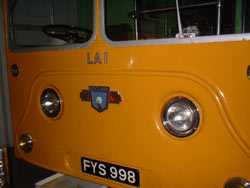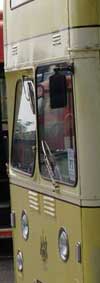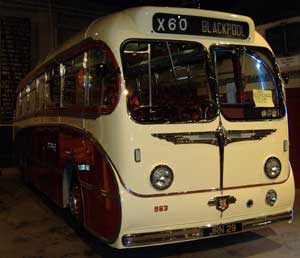
Leyland Bus
Atlantean

The photo above was taken at the Glasgow Transport Museum. This is the first production Atlantean LA1.
The bus photographed below also claims to be the first. They both came into service in December 1958. The Glasgow bus was from Alexander and the Wallasey bus from MCW.

Leyland buses are largely covered in the Leyland history page. This page covers the Atlantean and the Tiger Cub below. Other buses will be more fully described on the page linked here.
The story of the Atlantean is contained in a booklet called the 'Leyland Atlantean', Commercial Vehicles Archive Series. Available from the British Commercial Vehicle Museum, £1.50 as of July 2005.
Ubiquitous Leyland Atlantean Bus, designed and made by Leyland Motors, Leyland near Preston, Lancashire. This bus design was radical and innovative and transformed the shape of buses in the UK and all over the world. With its rear engine and front doors next to the driver it enabled single crew operation on a double decker. The drivers and conductors weren't happy originally. In some places it was operated by a full driver and conductor crew for several years. Can't say I'd like to drive such a big vehicle and work out the price of a ticket and the change for a queue of passengers. This bus held 78 passengers which was large for the time.
At the time the use of buses was reducing as people moved to cars. To the general public it may not have been apparent at the end of the 1950's but by the end of the 60's it was obvious to all.
The chassis / engine was built at Leyland and the bodies were built mainly by Metro-Cammell, Weymann, Saunders-Roe, Walter Alexander. Every now and then you would see a bare chassis being run around the local area for testing with a driver sat up front wearing goggles.
Many people didn't like the boxy shape, the way the engine stuck out at the back, the odd sideways seating downstairs and raised upper rear deck seats, the uneven location of the windows. Well I've got to say that I liked all those things. The Atlantean looked so modern.
There are versions with flat backs and tapered in upper decks; waste of time.
The front wheels are set back like a coach and enabled it to sweep round corners. It also sometimes looked like it was a bucking bronco with pronounced pitch movement, don't know why but some had air suspension so maybe it needed pumping up or possibly due to the front wheels being set back.
The basic shape of the Atlantean is still in todays buses. Below the 36 business class bus service Leeds - Harrogate - Ripon. I recently went to Harrogate and these buses seem to run very frequently, every 20 minutes it seems. Quite nice I think, also the illuminated destination boards are attractive and very readable. Click on it to go their website.
I'm not sure but these look like Wright Buses made in Northern Ireland on a Volvo chassis, well done to them, looks good, shame its not a Leyland. More local are the East Lancs Coach Works who make a similar bus. Time moves on and East Lancs are now called Optare. Wonder if the 36 still runs in 2009?
Ribble and Leyland buses on YouTube
YouTube has a lot of videos on buses although the quality is up and down. Click below to view a selection. The first one being from the Leyland Society Event 2007.
Ride Fishwick Olympian 521CTF inLeyland town Video
Ride a Leyland Tiger Cub video
Bradford PD3 video
Southend PD3 goodbye tour 1983 video
Carnforth Rally Photos 'video'
Ride a new Blackpool Atlantean video
Mixture of old videos on buses
Off topic - Routemaster Showbus 2006
Leyland National
This was e-mailed to me by the publisher in July 2007 but interesting for the website and probably more if you buy the book.
"New Book
The Leyland National
It is now three-and-a-half decades since the first Leyland National single-deck bus took to our roads. It was the ideal bus for the era concerned, and it therefore came to dominate the British market place. With its distinctive form being seen from Cornwall to the Northern half of Scotland, it formed the service bus backbone of many great fleets. It even had its own special assembly line, a purpose-built building at Lilyhall in West Cumbria. It was a product of the 1968 Transport Act and the formation of a National Bus Company, which would become the single largest buyer of public service vehicles in Europe, if not the world. To meet the demand for a uniform or standard single-deck service bus, the state-owned British Leyland group were given the opportunity to develop an integrally-engineered bus.
The new Leyland National was unveiled at the 1970 Commercial Motor Show, but an extensive proving programme was undertaken before the first production vehicles were released. Cumberland Motor Services had taken a pre-production model into service in early 1972, but the first production bus went to South East Lancashire and North East Cheshire Passenger Transport Executive later that year. This was the first of 3,500 virtually identical vehicles that were turned out, mostly in Poppy Red or Leaf Green liveries of the National Bus Company. The phase II model, incorporating a number of developments was announced in April 1976, and in 1978 Leyland introduced the B-series, aimed at the lighter end of the market.

Although developed jointly by Leyland and the National Bus Company, primarily for the NBCs own use, it found many other buyers amongst the major operators, particularly in its later forms. After the de-regulation of the bus industry in the 1980s, many Leyland Nationals became surplus to requirements, and they were sold to numerous independent operators where they were soon used to run in competition with their former owners. It is only since the start of the new century that the National has ceased to be an everyday sight on our streets. Its varied and colourful history is illustrated in this pictorial tribute to the Marque, being captured by the camera in a range of hues from the original Poppy Red or Leaf Green, to bright pink and multi-coloured versions. The fleets pictured vary from great undertakings like Crossville, Midland Red and United, to the smallest of independent operators. The book forms Volume Three of the Trans-Pennine Nostalgia Road's Buses In Colour Series.
Author Detail: Paul Chancellor was born in Somerset but moved to the North East of England upon taking up employment in the chemical industry with ICI, later moving to the Midlands. Rail and road transport have been a personal interest from an early age. Paul has written books and numerous articles on railway subjects as well as developing an extensive collection of rail and bus photographs.
Buses In Colour Vol. 3, The Leyland National (price 9.95) by Paul Chancellor (ISBN 978 903016 72 5)
www.transpenninepublishing.co.uk
London Transport last Leylands
London phased out its last Leyland buses after some 70 years of service on 14th October 2005, reports Buses magazine December 2005. The report also states that Leyland supplied London Transport with Trolleybuses, STD Titans, Londons first rear and underfloor engined single deckers and 1631 RTL and 500 RTW class double deckers between 1948 and 1954. 626 Routemaster engines, 50 Atlanteans (Londons first rear-engined double deckers) and 679 DMS Fleetlines in the 70's. The last Leylands being 40 Alexander bodied Olympians. Accessibility being the killer for the old buses, can't get a wheelchair on.
Tiger Cub

A superb example. Leyland Tiger Cub, 1956. Burlingham Seagull body. 41 seats, forward door. This is in the British Commercial Vehicle Museum and is privately owned. Ribble livery with authentic seat covering. Displaying X60 Manchester to Blackpool express service.
The Tiger Cub was first introduced in 1952.
Blackpool registered EFR 950 was the very first Burlingham Seagull coach to enter service and, in 1953, it carried the victorious Blackpool Football Team after winning the FA Cup. A Corgi Classic Original Omnibus was produced of this in 1998, it is discontinued but could be available on EBAY.
Burlingham was in Blackpool and was taken over by Duple before closing. It was in Marton, telephone number Blackpool 251. See here.
ECK426 was Ribble Motors first Burlingham Seagull Mk2 in 1953. It had centre door and 32 seats for comfortable touring.
A large book called 'The Leyland Bus' by Doug Jack ISBN 0-903839-11-3, printed in 1977 has been located. 440 pages of detailed information about Leyland Buses. An example is that Preston Corporation converted 8 PD2/10 Titans from rear open entrance to forward door entrance with PD3 mainframes. Preston then had the only 7ft 6in wide PD3 Titans. This took place between 1959 and 1967, approx 1 a year. Registration number ECK509 became PRN761.
British Commercial Vehicle Museum, Leyland.
